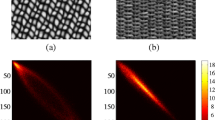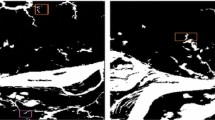Abstract
The authentication of natural medical herbs has crucial impact on the clinical curative effect. Much of these herbs have been ground into powders in the market, leading to the difficulty of identification. Microscopic images of these powders contain important evidences for identification. Currently identification based on these microscopic images are mostly conducted by manual observation. Identification aided by computer vision technique is an important research subject recently. These microscopic images usually contain variety of substance, and most of them are noises, thus the target segmentation is necessary for identification. An effective automatic target segmentation algorithm based on texture is proposed in this paper. Our method consists of two steps: “Preliminary Segmentation” and “Further Segmentation”. Firstly, gradient transform and image fusion are conducted for image preprocessing, then each pixel is encoded into a feature vector based on texture and clustered into two groups: background and foreground. Secondly, taking the continuity of edge and the locality of target into consideration, energy equations are established, and maximum flow-minimum cut algorithm is applied to solve them. Three groups of images are tested to evaluate our method, and the experimental results show that our method achieves a better segmentation compared with Grab-Cut, and additionally user inter-action is not required in our method.










Similar content being viewed by others
References
Shen, Y., Yaoli, L., Yixu, S., Li, L., Peifa, J., Shaoqing, C. (2012). Identification of chinese materia medicas in microscopic powder images. Tsinghua Science and Technology.
Richard, S. (2010). Computer vision: algorithms and applications (pp. 206–217).
Zhang, L., & Ji, Q. (2011). A bayesian network model for automatic and Interactive image segmentation. IEEE Transactions on Image Processing, 20(9).
Boskovitz, V., & Guterman, H. (2002). An adaptive neuro-fuzzy system for automatic image segmentation and edge detection. IEEE Transactions on Fuzzy Systems, 10(2), 247–261.
Ren, X., Fowlkes, C.C., Malik, J. (2008). Learning probabilistic models for contour completion in natural images. International Journal of Computer Vision, 47–63.
Rohlfing, T., Brandt, R., Menzel, R., Maurer, C.R. Jr. (2003). Evaluation of atlas selection strategies for atlas-based image segmentation with application to confocal microscopy images of bee brains, neuroimage.
Au, D.T., Chen, H., Jiang, Z., Zhao*, Z. (2008). A novel method to identify the Chinese herbal medicine Wuzimaotao by quantification of laticifers. Microscopy Research and Technique.
Du, C.-J., Ferguson, J.G., Hawkins, P.T., Stephens, L.R., Bretschneider*, T. (2012). Fast random walker for neutrophil cell segmentation in 3D. International Symposium on Biomedical Imaging (ISBI).
Choomchuay, S., & Sihalath, K. (2010). An application of second derivative of gaussian filters in fingerprint image enhancement, bioinformatics and biomedical engineering (iCBBE).
Remagnino, P., Barman, S., Cope, J.S., Wilkin, P. (2010). Plant texture classification using Gabor Co-Occurrences. Springer.
Luo, M., Ma, Y.-F., Zhang, H.-J. (2003). A spatial constrained K-means approach to image segmentation. Information, Communications and Signal Processing.
Wischmeier, W.H., & Smith, D.D. (2001). Predicting rainfall erosion losses—a guide to conservation planning. Machine Learning.
Rother, C., Kolmogorov, V., Blake, A. (2004). GrabCut—Interactive Foreground Extraction using Iterated Graph Cuts. SIGGRAPH.
Boykov, Y.Y., & Jolly, M.-P. (2001). Interactive graph cuts for optimal boundary & region segmentation of objects in N-D images. ICCV.
Li, L., Wu, J., Zhu, S. (2009). Implicatio intensity: randomized F-measure for cluster evaluation. Service Systems and Service Management, 2009. In ICSSSM 09. 6th international conference on. IEEE.
Author information
Authors and Affiliations
Corresponding authors
Rights and permissions
About this article
Cite this article
Li, J., Song, YX., Li, YL. et al. Automatic Target Segmentation based on Texture for Microscopic Images of Natural Medical Herbal Powders. J Sign Process Syst 78, 139–146 (2015). https://doi.org/10.1007/s11265-013-0839-y
Received:
Revised:
Accepted:
Published:
Issue Date:
DOI: https://doi.org/10.1007/s11265-013-0839-y




